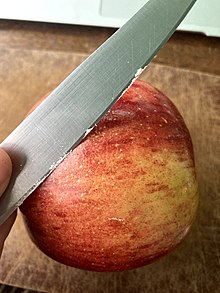
Fruit waxing is the process of covering fruits (and, in some cases, vegetables) with artificial waxing material. Natural wax is removed first, usually by washing, followed by a coating of a biological or petroleum derived wax. Potentially allergenic proteins (peanut, soy, dairy, wheat) may be combined with shellac.
The primary reasons for waxing are to prevent water loss (after the removal in washing of the natural waxes in fruits that have them, particularly citrus but also, for example, apples) and thus slow shrinkage and spoilage, and to improve appearance. Dyes may be added to further enhance appearance, and sometimes fungicides. Fruits were waxed to cause fermentation as early as the 12th or the 13th century; commercial producers began waxing citrus to extend shelf life in the 1920s and 1930s. Aesthetics (consumer preference for shiny fruit) has since become the main reason. In addition to fruit, some vegetables can usefully be waxed, such as cassava. A distinction may be made between storage wax, pack-out wax (for immediate sale), and high-shine wax (for optimum attractiveness).
Products that are often waxed
A number of sources list the following as products which may be waxed before shipping to stores:
- apples
- avocados
- bell and hot peppers
- cucumbers
- eggplant
- grapefruit
- lemons
- limes
- mangoes
- melons
- nectarines
- oranges
- papayas
- parsnips
- passion fruit
- peaches
- pears
- pineapple
- plums
- pumpkins
- rutabaga
- squash
- sweet potatoes
- tangarines
- tomatoes
- turnips
- yucca
Materials
The materials used to wax produce depend to some extent on regulations in the country of production and/or export. Both natural waxes (carnauba, shellac, beeswax or resin) and petroleum-based waxes (usually proprietary formulae) are used, and often more than one wax is combined to create the desired properties for the fruit or vegetable being treated. Wax may be applied in a volatile petroleum-based solvent but is now more commonly applied via a water-based emulsion. Blended paraffin waxes applied as an oil or paste are often used on vegetables.
See also
References
- Baldwin, Elizabeth (2007). "Surface Treatments and Edible Coatings in Food Preservation". Handbook of Food Preservation, Second Edition. pp. 484–6. CiteSeerX 10.1.1.188.4630. ISBN 978-1-57444-606-7.
- ^ P. E. Kolattukudy, "Natural Waxes on Fruits" Archived 2017-05-20 at the Wayback Machine, Post Harvest Pomology Newsletter 2.2 (1984), repr. Tree Fruit Research and Extension Center, Washington State University, March 2003 (pdf)
- ^ Leo J. Klotz, Walter Reuther, E. Clair Calavan, Glenn E. Carman, et al., The Citrus Industry Volume 5 Crop Protection, Postharvest Technology, and Early History of Citrus Research in California, ANR publications (University of California, Oakland) 3326, rev. ed. Berkeley: University of California, 1989, p. 182.
- ^ Keith Thompson, Fruit and Vegetables: Harvesting, Handling and Storage, Oxford: Blackwell / Ames, Iowa: Iowa State, 2003, ISBN 9781405106191, p. 287.
- ^ Frank D. Gunstone and Fred B. Padley, Lipid Technologies and Applications, New York: Dekker, 1997, p. 463.
- Thompson, p. 188.
- ^ L. R. Verma and V. K. Joshi, Postharvest Technology of Fruits and Vegetables: Handling, Processing, Fermentation, and Waste Management, Volume 1 General Concepts and Principles, New Delhi: Indus, 2000, ISBN 9788173871085, p. 120.
- "Wax on products - MSU Extension". 2018-11-04. Archived from the original on 2018-11-04. Retrieved 2019-11-04.
- Heber, David (2013-08-20). "Facts on Wax: Are Vegetables and Fruit Waxes Kosher?". STAR-K Kosher Certification. Archived from the original on 9 July 2017. Retrieved 2019-11-04.
- Means, Kathy (8 May 2014). "Wax Labeling". Products Marketing Association. Archived from the original on 13 July 2018. Retrieved 2019-11-04.
- John M. Krochta, Elizabeth A. Baldwin and Myrna O. Nisperos-Carriedo, Eds., Edible Coatings and Films to Improve Food Quality, Lancaster, Pennsylvania: Technomic, 1994, ISBN 9781566761130, p. 37.
- "Carnauba WaxHandling/Processing, USDA petitioned substance for Organic standards" (PDF). United States Department of Agriculture.
Further reading
- V. Thirupathi, S. Sasikala and Z. John Kennedy. "Preservation of fruits and vegetables by wax coating". Science Tech Entrepreneur August 2006. Online at scribd.com.
- Barbara Ritter, Jörg Schulte, Erhard Schulte and Hans-Peter Thier. "Detection of coating waxes on apples by differential scanning calorimetry". European Food Research and Technology 212.5 (2000) 603–07 (pdf)